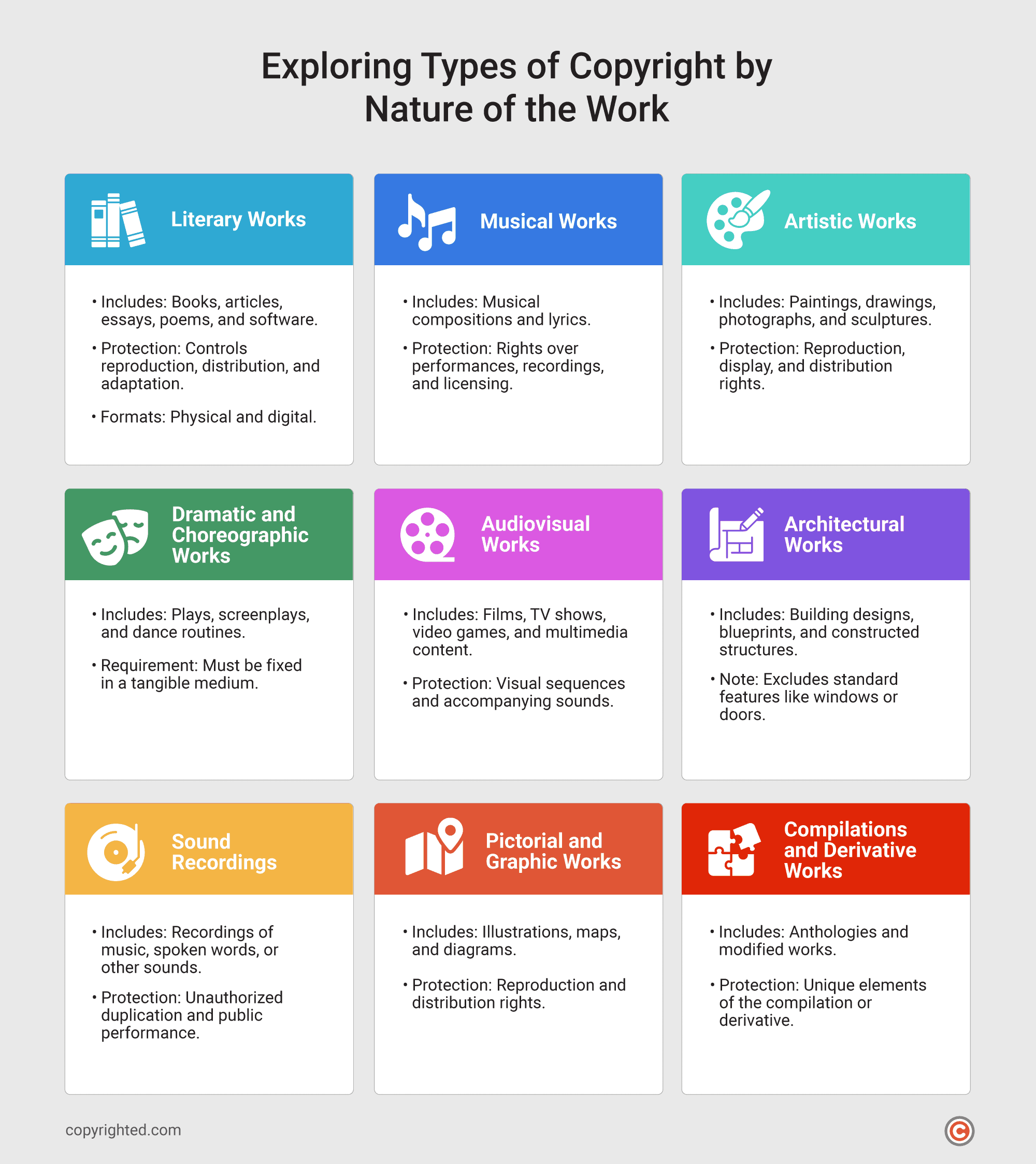Ever wondered if the content you create, whether it’s a catchy song, a stunning photo, or a groundbreaking invention, can be protected?
Understanding copyright is more than just legal jargon; it’s the key to safeguarding your creativity. Without it, your hard work might be copied, misused, or even stolen, leaving you frustrated and unrecognized.
The article below explores the types of copyright, breaking down a complex topic into clear, digestible parts. You’ll learn about the various ways intellectual property can be protected and why knowing which type applies to you is vital.
Stick around, and by the end, you’ll feel equipped to take charge of your rights as a creator!
- Copyright protects a wide range of creator’s works, including literary, musical, artistic, audiovisual, and architectural creations, ensuring creators retain control over their intellectual property.
- International agreements like the Berne Convention and TRIPS Agreement establish global standards for copyright protection, fostering consistency across borders.
- Special copyright considerations, such as fair use, public domain, and Creative Commons licenses, balance creators’ rights with public access and usage.
Table of Contents
Why Do You Need to Understand Copyright Types?
You need to understand copyright types to protect your creative work, use others’ content legally, and operate businesses without legal risks.
It’s important for everyone, including creators, users, and businesses, because it affects how intellectual property is protected, shared, and used. Here’s why it matters:
- Protect Your Work: If you’re a creator, knowing the different kinds of copyrights helps you ensure your work is properly protected under the law. For example, Section 102 of the U.S. Copyright Act lists specific categories of works eligible for copyright protection, from literary works to sound recordings.
- Avoid Legal Issues: Users of copyrighted material, such as artists, students, or businesses, can avoid legal trouble by understanding the rights attached to different types of works. For instance, works in the public domain or those eligible for fair use have fewer restrictions, but that doesn’t apply to all copyrighted material.
- Save Time and Money: Businesses and creators alike can save time and money by understanding what they can and cannot use. Licensing copyrighted materials improperly or missing the opportunity to protect your own work can result in costly errors.
- Promote Collaboration: If you understand how copyright works, it’s easier to share or license your work without losing your rights or accidentally infringing on someone else’s. This is particularly important in the publishing, tech, and entertainment industries, where collaborations are common.
Types of Copyright Law
Copyright law operates through international agreements that set standards for protecting intellectual property across borders. These agreements ensure creators have their rights recognized and enforced globally.
Berne Convention
Established in 1886, the Berne Convention ensures that works created in one member country are automatically protected in all others without requiring formal registration.
It emphasizes the principle of “national treatment,” meaning works are granted the same rights as those of a local creator in the country where legal protection is sought. It also introduces moral rights, allowing creators to claim authorship and object to modifications of their work.
Universal Copyright Convention (UCC)
Adopted in 1952, the UCC provides an alternative for countries not part of the Berne Convention. It requires member states to offer minimum protections, such as copyright lasting at least the author’s lifetime plus 25 years.
The UCC emphasizes flexibility, allowing nations to adapt copyright rules while ensuring basic international standards.
Trade-Related Aspects of Intellectual Property Rights (TRIPS) Agreement
This agreement, enforced by the World Trade Organization (WTO) since 1995, sets strict intellectual property standards for all member countries.
It incorporates elements of the Berne Convention while adding provisions for enforcement, dispute resolution, and protection for new forms of intellectual property, such as software and databases.
Types of Copyright by Nature of the Work
Copyright applies to various types of creative and intellectual works, each protected under specific provisions of the U.S. Copyright Office. These categories ensure that creators’ rights are safeguarded for a wide range of artistic and functional creations.
Here are the types of copyright by nature of the work:

- Literary Works: Includes books, articles, essays, poems, and even computer software. These works are protected in both physical and digital formats, ensuring authors control reproduction, distribution, and adaptation.
- Musical Works: Covers compositions (notes and arrangements) and accompanying lyrics. This type of copyright ensures creators have the right to control performances, recordings, and licensing.
- Artistic Works: Encompasses paintings, drawings, photographs, sculptures, and other visual art forms. Protection includes the exclusive right of the copyright owner to reproduce, display, or distribute the artwork.
- Dramatic and Choreographic Works: Includes plays, screenplays, and choreographed dance routines. To be eligible for copyright, these works must be fixed in a tangible medium, like written scripts or recorded performances.
- Audiovisual Works: Includes films, TV shows, video games, and online multimedia content. Copyright covers the visual sequences and accompanying sounds, protecting creators from unauthorized use or distribution.
- Architectural Works: Protects the design of buildings, as long as the structure is both functional and artistic. This protection includes blueprints and constructed designs but excludes standard features like windows or doors.
- Sound Recordings: Refers to the actual recording of music, spoken words, or other sounds, distinct from musical compositions. It ensures protection against unauthorized duplication or public performance of the recording.
- Pictorial and Graphic Works: Includes illustrations, maps, diagrams, and technical drawings. This type ensures creators maintain control over the reproduction and distribution of their visual designs.
- Compilations and Derivative Works: Protects works created by compiling pre-existing material like anthologies or modifying original works to create new content. The copyright applies only to the unique elements of the compilation or derivative.
These categories highlight the scope of intellectual property protection, ensuring creators across various industries have the legal backing to control how their works are used and shared.
Categories of Copyright Works
Copyright works can be categorized based on their publication status, authorship, or origin. Each category has distinct rules and protections outlined in the U.S. Copyright Act.
Below are the key categories:
- Published vs. Unpublished Works: Copyright protects both published and unpublished works under 17 U.S. Code § 104. Published works are distributed to the public with the creator’s consent, while unpublished works are protected the moment they are fixed in a tangible medium, regardless of public availability.
- Joint Works: Joint works are created by two or more authors who intend their contributions to merge into a single, unified piece. Each co-author holds equal copyright ownership unless otherwise agreed, and all must consent to licenses or other uses of the work.
- Collective Works: These are compilations like anthologies, encyclopedias, or magazines, where independent works by various authors are collected into a whole. The copyright for the collective work is separate from the individual copyrights of the included works.
- Works Made for Hire: A “work made for hire” refers to works created by an employee within their job scope or under a contract specifically stating the work is for hire. In these cases, the employer or hiring party, not the individual creator, is considered the copyright owner.
- Government Works: Works created by the U.S. government are generally not protected by copyright under 17 U.S. Code § 105. This ensures public access to government publications and resources, though works created under government contracts may have different rules.
Understanding these categories helps creators, collaborators, and users navigate copyright rights and responsibilities in different contexts, ensuring compliance with legal standards.
Types of Copyright Protections
Copyright law grants creators specific rights to control how their works are used, reproduced, and shared. These protections are detailed in 17 U.S. Code § 106 and serve to ensure that creators can benefit from their intellectual property.
Here are the main types of copyright protections:
- Reproduction Rights: The copyright owner has the exclusive right to reproduce their work in any format. This applies to making physical or digital copies of books, recordings, artworks, or other materials.
- Distribution Rights: This protection allows the copyright holder to control the distribution of their work, whether through sales, rentals, or transfers. Unauthorized sharing, such as piracy, violates this right.
- Public Performance Rights: Copyright owners have the right to control how people perform the work, such as staging a play, broadcasting a song, or screening a film in a public venue.
- Public Display Rights: For visual works, such as paintings or photographs, the copyright holder has the right to control how and where their works are displayed publicly, such as in galleries or on digital platforms.
- Rights for Derivative Works: Copyright owners can authorize the creation of new works based on their original work, such as turning a book into a movie or a song into a remix. Unauthorized adaptations violate this protection.
These rights ensure creators have control over their intellectual property, enabling them to manage its use and derive financial or reputational benefits while preventing unauthorized exploitation.
Special Types of Copyright Protections
Certain works and circumstances have unique copyright considerations, offering exceptions or alternative frameworks to the traditional rules. These special protections are designed to balance creators’ rights with public access and utility.
Fair Use and Limitations
Under Section 107 of the U.S. Copyright Act, fair use allows limited use of copyrighted material without permission for specific purposes, such as criticism, news reporting, education, research, and parody.
Courts determine fair use based on factors like the purpose of use, the nature of the work, the amount used, and its effect on the market value of the original.
Public Domain
Works enter the public domain when their copyright protection expires, they are created by the U.S. government, or the copyright holder explicitly waives their rights. Public domain works can be freely used, reproduced, or adapted without permission.
Creative Commons Licenses
A modern licensing system, Creative Commons (CC) allows creators to specify how others can use their work.
These licenses range from allowing unrestricted use to permitting only non-commercial or non-derivative use, giving creators control while encouraging sharing and collaboration.
Frequently Asked Questions
What rights does copyright give to creators?
Copyright grants creators control over reproduction, distribution, public performance, public display, and derivative works of their creations.
What types of works are not eligible for copyright protection?
Ideas, procedures, systems, methods of operation, and works not fixed in a tangible medium are not eligible for copyright protection.
Can the same work fall under multiple types of copyright?
Yes, a work like a musical performance can involve multiple copyrights, such as for the composition and the sound recording.
How is copyright applied internationally?
International copyright protection is governed by treaties like the Berne Convention, which ensures rights are recognized across member countries.
How does copyright differ from other forms of intellectual property?
Copyright protects creative works, while trademarks protect branding elements, patents safeguard inventions, and trade secrets secure proprietary business information.


